Jordi Armengol-Estapé
Don't Transform the Code, Code the Transforms: Towards Precise Code Rewriting using LLMs
Oct 11, 2024
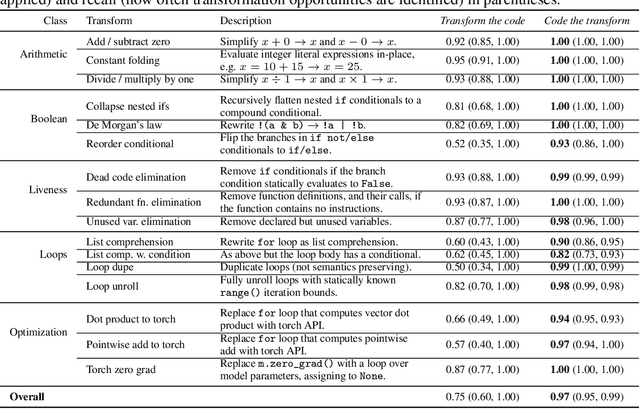
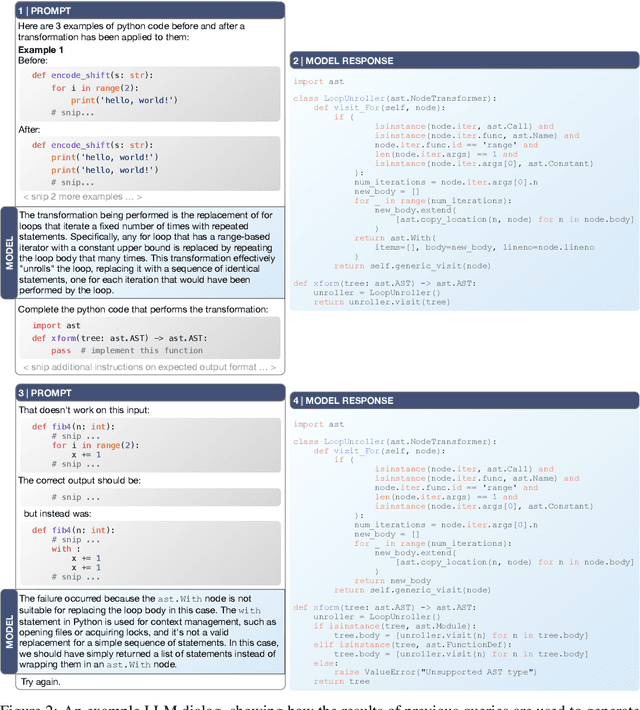

Abstract:Tools for rewriting, refactoring and optimizing code should be fast and correct. Large language models (LLMs), by their nature, possess neither of these qualities. Yet, there remains tremendous opportunity in using LLMs to improve code. We explore the use of LLMs not to transform code, but to code transforms. We propose a chain-of-thought approach to synthesizing code transformations from a small number of input/output code examples that incorporates execution and feedback. Unlike the direct rewrite approach, LLM-generated transformations are easy to inspect, debug, and validate. The logic of the rewrite is explicitly coded and easy to adapt. The compute required to run code transformations is minute compared to that of LLM rewriting. We test our approach on 16 Python code transformations and find that LLM- generated transforms are perfectly precise for 7 of them and less imprecise than direct LLM rewriting on the others. We hope to encourage further research to improving the precision of LLM code rewriting.
On the Limits of Multi-modal Meta-Learning with Auxiliary Task Modulation Using Conditional Batch Normalization
May 29, 2024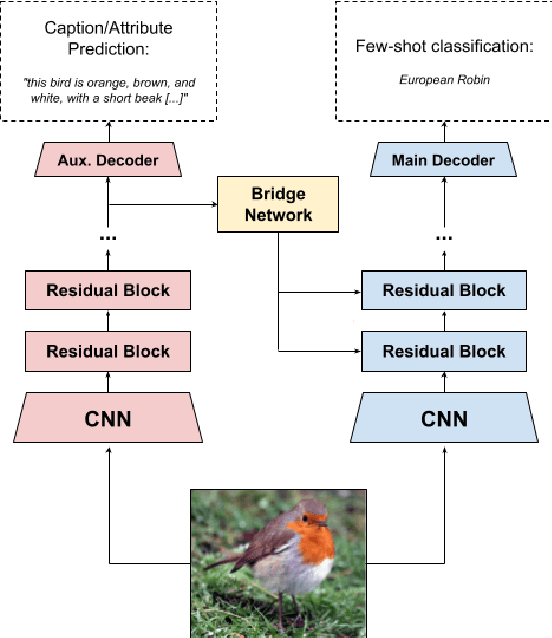
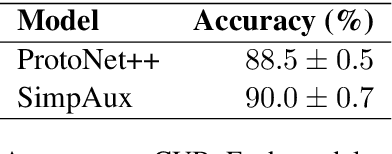
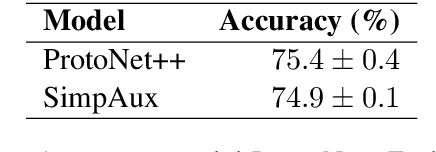
Abstract:Few-shot learning aims to learn representations that can tackle novel tasks given a small number of examples. Recent studies show that cross-modal learning can improve representations for few-shot classification. More specifically, language is a rich modality that can be used to guide visual learning. In this work, we experiment with a multi-modal architecture for few-shot learning that consists of three components: a classifier, an auxiliary network, and a bridge network. While the classifier performs the main classification task, the auxiliary network learns to predict language representations from the same input, and the bridge network transforms high-level features of the auxiliary network into modulation parameters for layers of the few-shot classifier using conditional batch normalization. The bridge should encourage a form of lightweight semantic alignment between language and vision which could be useful for the classifier. However, after evaluating the proposed approach on two popular few-shot classification benchmarks we find that a) the improvements do not reproduce across benchmarks, and b) when they do, the improvements are due to the additional compute and parameters introduced by the bridge network. We contribute insights and recommendations for future work in multi-modal meta-learning, especially when using language representations.
SLaDe: A Portable Small Language Model Decompiler for Optimized Assembler
May 21, 2023



Abstract:Decompilation is a well-studied area with numerous high-quality tools available. These are frequently used for security tasks and to port legacy code. However, they regularly generate difficult-to-read programs and require a large amount of engineering effort to support new programming languages and ISAs. Recent interest in neural approaches has produced portable tools that generate readable code. However, to-date such techniques are usually restricted to synthetic programs without optimization, and no models have evaluated their portability. Furthermore, while the code generated may be more readable, it is usually incorrect. This paper presents SLaDe, a Small Language model Decompiler based on a sequence-to-sequence transformer trained over real-world code. We develop a novel tokenizer and exploit no-dropout training to produce high-quality code. We utilize type-inference to generate programs that are more readable and accurate than standard analytic and recent neural approaches. Unlike standard approaches, SLaDe can infer out-of-context types and unlike neural approaches, it generates correct code. We evaluate SLaDe on over 4,000 functions from AnghaBench on two ISAs and at two optimizations levels. SLaDe is up to 6 times more accurate than Ghidra, a state-of-the-art, industrial-strength decompiler and up to 4 times more accurate than the large language model ChatGPT and generates significantly more readable code than both.
esCorpius: A Massive Spanish Crawling Corpus
Jul 01, 2022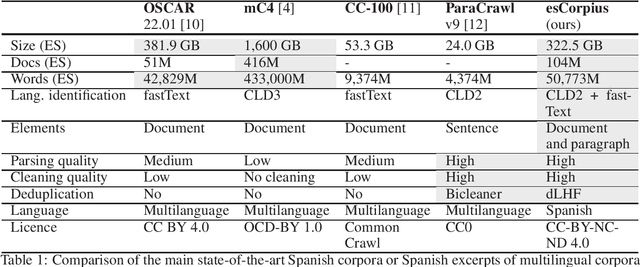
Abstract:In the recent years, transformer-based models have lead to significant advances in language modelling for natural language processing. However, they require a vast amount of data to be (pre-)trained and there is a lack of corpora in languages other than English. Recently, several initiatives have presented multilingual datasets obtained from automatic web crawling. However, the results in Spanish present important shortcomings, as they are either too small in comparison with other languages, or present a low quality derived from sub-optimal cleaning and deduplication. In this paper, we introduce esCorpius, a Spanish crawling corpus obtained from near 1 Pb of Common Crawl data. It is the most extensive corpus in Spanish with this level of quality in the extraction, purification and deduplication of web textual content. Our data curation process involves a novel highly parallel cleaning pipeline and encompasses a series of deduplication mechanisms that together ensure the integrity of both document and paragraph boundaries. Additionally, we maintain both the source web page URL and the WARC shard origin URL in order to complain with EU regulations. esCorpius has been released under CC BY-NC-ND 4.0 license and is available on HuggingFace.
Sequence-to-Sequence Resources for Catalan
Feb 14, 2022
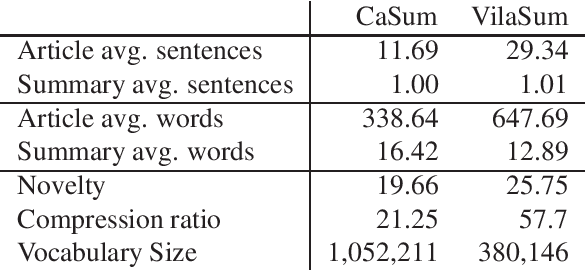
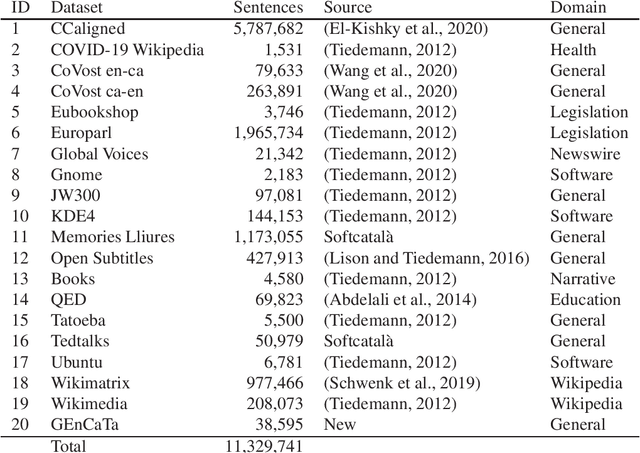

Abstract:In this work, we introduce sequence-to-sequence language resources for Catalan, a moderately under-resourced language, towards two tasks, namely: Summarization and Machine Translation (MT). We present two new abstractive summarization datasets in the domain of newswire. We also introduce a parallel Catalan-English corpus, paired with three different brand new test sets. Finally, we evaluate the data presented with competing state of the art models, and we develop baselines for these tasks using a newly created Catalan BART. We release the resulting resources of this work under open license to encourage the development of language technology in Catalan.
The Large Labelled Logo Dataset (L3D): A Multipurpose and Hand-Labelled Continuously Growing Dataset
Dec 10, 2021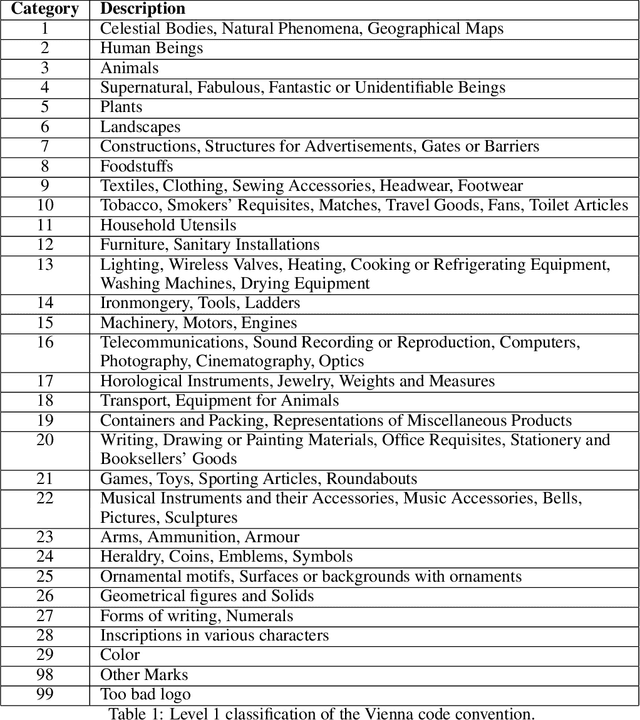
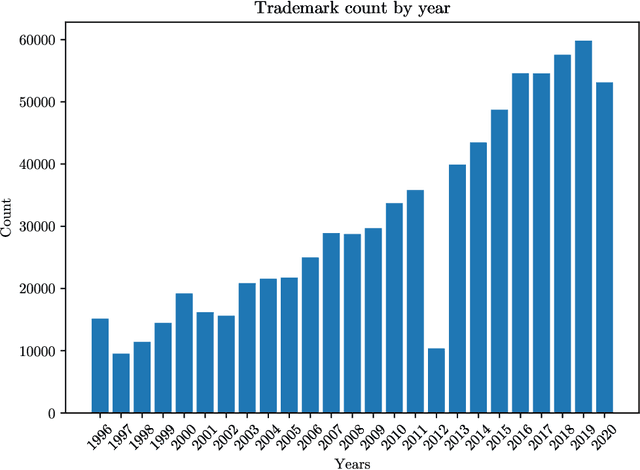
Abstract:In this work, we present the Large Labelled Logo Dataset (L3D), a multipurpose, hand-labelled, continuously growing dataset. It is composed of around 770k of color 256x256 RGB images extracted from the European Union Intellectual Property Office (EUIPO) open registry. Each of them is associated to multiple labels that classify the figurative and textual elements that appear in the images. These annotations have been classified by the EUIPO evaluators using the Vienna classification, a hierarchical classification of figurative marks. We suggest two direct applications of this dataset, namely, logo classification and logo generation.
FinEAS: Financial Embedding Analysis of Sentiment
Nov 19, 2021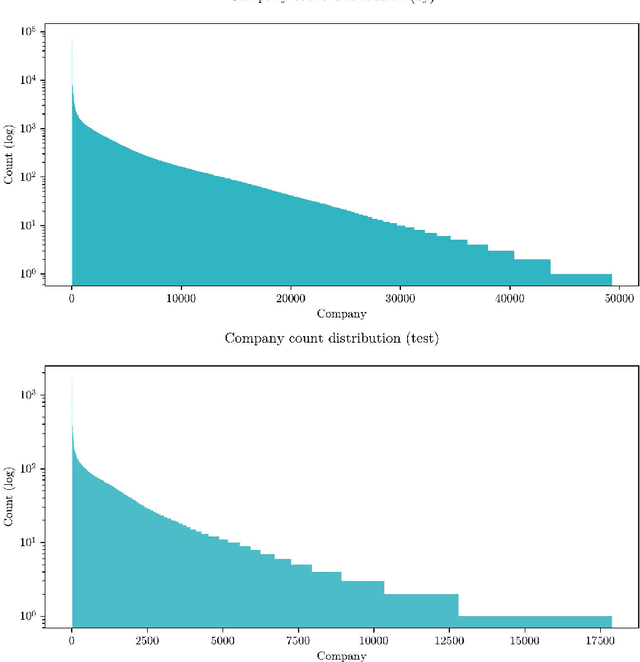
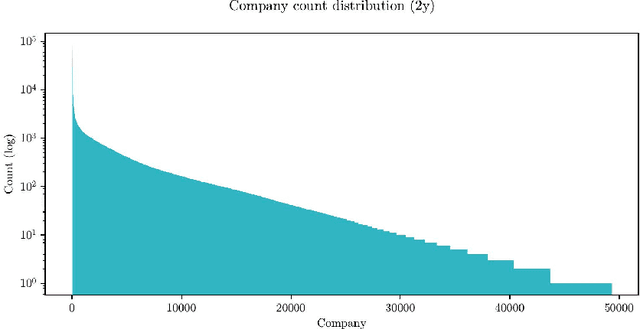
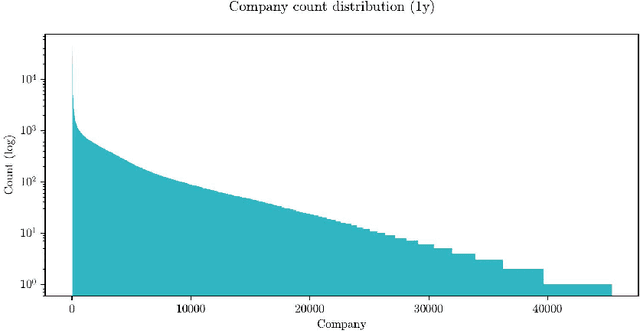
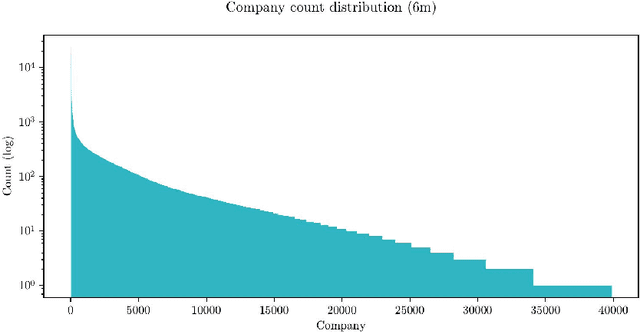
Abstract:We introduce a new language representation model in finance called Financial Embedding Analysis of Sentiment (FinEAS). In financial markets, news and investor sentiment are significant drivers of security prices. Thus, leveraging the capabilities of modern NLP approaches for financial sentiment analysis is a crucial component in identifying patterns and trends that are useful for market participants and regulators. In recent years, methods that use transfer learning from large Transformer-based language models like BERT, have achieved state-of-the-art results in text classification tasks, including sentiment analysis using labelled datasets. Researchers have quickly adopted these approaches to financial texts, but best practices in this domain are not well-established. In this work, we propose a new model for financial sentiment analysis based on supervised fine-tuned sentence embeddings from a standard BERT model. We demonstrate our approach achieves significant improvements in comparison to vanilla BERT, LSTM, and FinBERT, a financial domain specific BERT.
Spanish Legalese Language Model and Corpora
Oct 23, 2021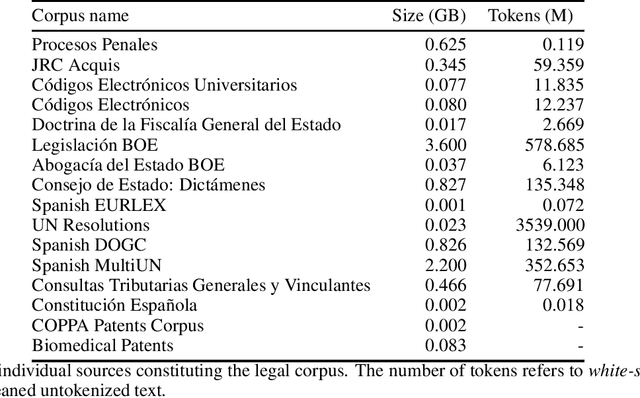
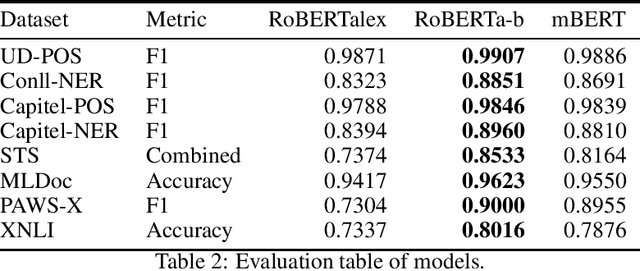
Abstract:There are many Language Models for the English language according to its worldwide relevance. However, for the Spanish language, even if it is a widely spoken language, there are very few Spanish Language Models which result to be small and too general. Legal slang could be think of a Spanish variant on its own as it is very complicated in vocabulary, semantics and phrase understanding. For this work we gathered legal-domain corpora from different sources, generated a model and evaluated against Spanish general domain tasks. The model provides reasonable results in those tasks.
Biomedical and Clinical Language Models for Spanish: On the Benefits of Domain-Specific Pretraining in a Mid-Resource Scenario
Sep 17, 2021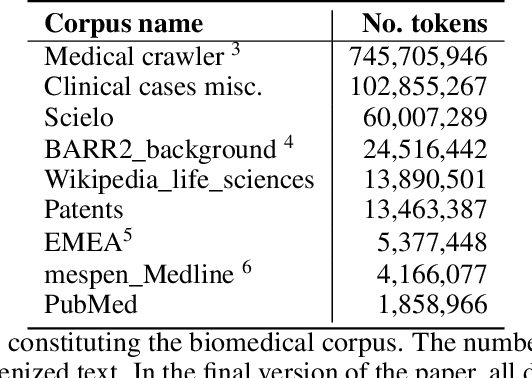
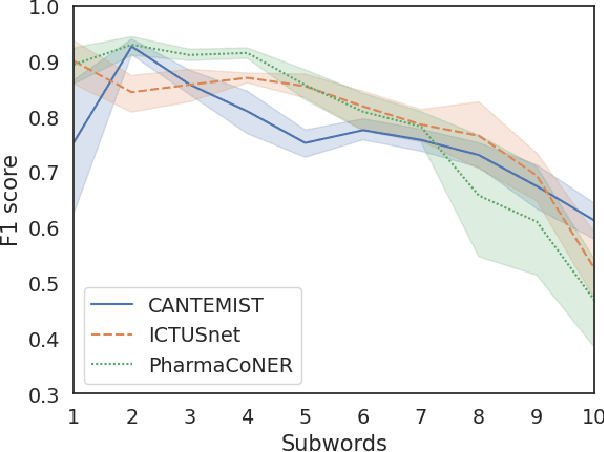
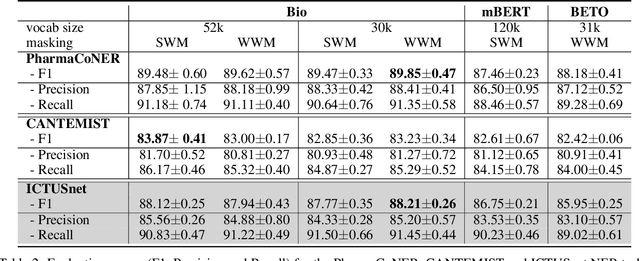
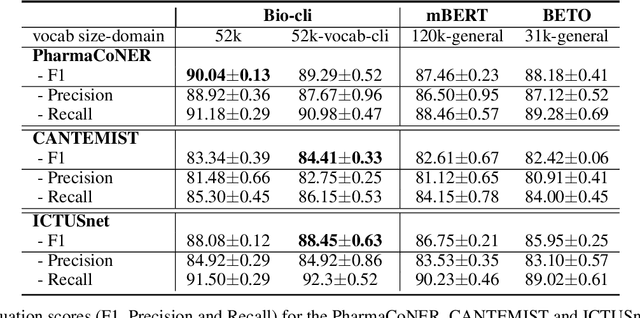
Abstract:This work presents biomedical and clinical language models for Spanish by experimenting with different pretraining choices, such as masking at word and subword level, varying the vocabulary size and testing with domain data, looking for better language representations. Interestingly, in the absence of enough clinical data to train a model from scratch, we applied mixed-domain pretraining and cross-domain transfer approaches to generate a performant bio-clinical model suitable for real-world clinical data. We evaluated our models on Named Entity Recognition (NER) tasks for biomedical documents and challenging hospital discharge reports. When compared against the competitive mBERT and BETO models, we outperform them in all NER tasks by a significant margin. Finally, we studied the impact of the model's vocabulary on the NER performances by offering an interesting vocabulary-centric analysis. The results confirm that domain-specific pretraining is fundamental to achieving higher performances in downstream NER tasks, even within a mid-resource scenario. To the best of our knowledge, we provide the first biomedical and clinical transformer-based pretrained language models for Spanish, intending to boost native Spanish NLP applications in biomedicine. Our best models are freely available in the HuggingFace hub: https://huggingface.co/BSC-TeMU.
Spanish Biomedical Crawled Corpus: A Large, Diverse Dataset for Spanish Biomedical Language Models
Sep 16, 2021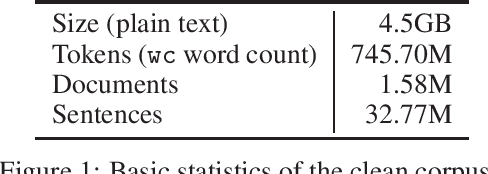
Abstract:We introduce CoWeSe (the Corpus Web Salud Espa\~nol), the largest Spanish biomedical corpus to date, consisting of 4.5GB (about 750M tokens) of clean plain text. CoWeSe is the result of a massive crawler on 3000 Spanish domains executed in 2020. The corpus is openly available and already preprocessed. CoWeSe is an important resource for biomedical and health NLP in Spanish and has already been employed to train domain-specific language models and to produce word embbedings. We released the CoWeSe corpus under a Creative Commons Attribution 4.0 International license, both in Zenodo (\url{https://zenodo.org/record/4561971\#.YTI5SnVKiEA}).
 Add to Chrome
Add to Chrome Add to Firefox
Add to Firefox Add to Edge
Add to Edge